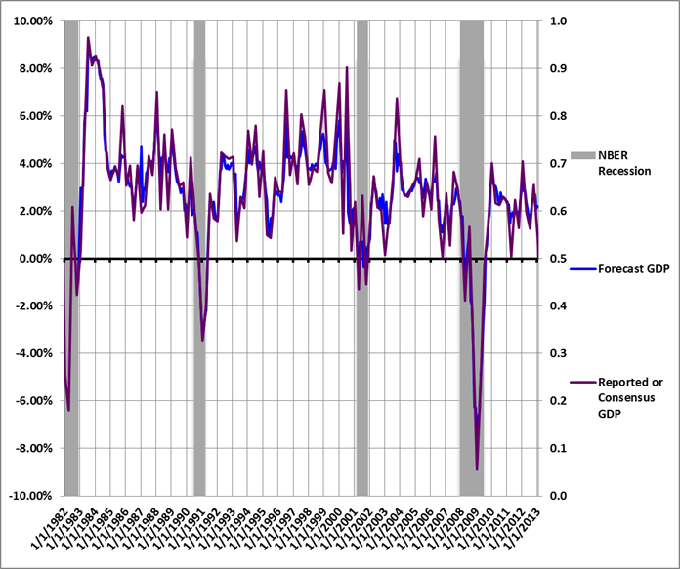The following article introduces a new aggregate neural network model that was designed to forecast the seasonally-adjusted, annualized, real rate of change in U.S. GDP.
I have been doing recession research and constructing recession models for the past several months, which prompted me to develop the GDP model. If you are new to Trader Edge and would like some additional background on the development of the Trader Edge recession models, I encourage you to read the previous recession model update, which also has links to earlier articles.
Aggregate GDP Model
The Trader Edge aggregate GDP model represents the average of two neural network model forecasts. Neural networks are extremely powerful and great care must be used to avoid over-fitting the data. As a result, before constructing the models, I divided the data into three separate groups: training, cross-validation, and testing. The training data was used to train the neural network models. The cross-validation data was used (in conjunction with the training data) to identify the best variable combinations and the optimal number of processing elements. Finally, the testing data was used to ensure generalized solutions that were applicable to data outside the training data-set.
When constructing the two neural network GDP models, I started with the same data that I used to develop the recession models. For the first model, I identified the optimal look-back period for each of the independent variables and discarded variables that had limited explanatory power. I then estimated several neural network models with different architectures and retained the one with the best overall performance.
For the second neural network model, I started with the same data, but let the neural network model choose the best combination of independent variables using a greedy algorithm. This is a time-consuming process that initially constructs neural network models for every variable, identifying the best variable, then uses that variable with all other individual variables to construct two variable models. It then identifies the best pair of variables, then continues the process. The algorithm terminates at the point when the estimation results for the training, cross-validation, and testing sets diverge - in other words, when the model begins to over-fit the training data.
While the GDP data is only released quarterly, I interpolated the actual GDP data to create monthly observations and monthly forecasts. Each monthly forecast represents a rolling three-month GDP forecast, lagged by one month. This is consistent the quarterly reporting lag; GDP is reported one month after the end of each calendar quarter.
While the interpolated monthly data is obviously not official, there is some logic to using a weighted-average of the quarterly GDP data to create monthly observations. In addition, this approach tripled the amount of data, which was beneficial from a modeling perspective. Finally, I plan to run the GDP model monthly to provide more timely insights into changes in GDP.
Historical Results
The Trader Edge aggregate GDP model performed well historically. The standard error of the estimate was a respectable 0.74%.
The model forecasts from 2000 to 1/1/2013 are included in Figure 1 below (blue). The purple line illustrates the actual quarterly GDP data. Both lines use the left vertical axis. The most recent "actual" GDP observation represents the briefing.com consensus GDP estimate of +1.0%. The gray shaded regions represent past U.S. recessions as defined by the National Bureau of Economic Research (NBER).
Since this article introduces the Trader Edge aggregate GDP model for the first time, I also wanted to provide a more comprehensive forecast history. Please see Figure 2 below.
Q4 2012 GDP Forecast
As mentioned above, the most recent "actual" GDP observation represents the briefing.com consensus GDP estimate of +1.0%. The first estimate of Q4 2012 GDP growth will be released on Wednesday January 30, 2013 at 8:30 EST. The aggregate model forecast is +2.2%, which is 1.2% above the briefing.com consensus.
James Picerno, the editor of CapitalSpectator.com, also publishes a GDP model forecast. His latest forecast for Q4 2012 is available here. Figure 3 below is from the latest Capital Spectator forecast. The Average Capital Spectator Econometric GDP Nowcast (Jan 25) was +2.0%. This forecast is only slightly lower than the Trader Edge GDP forecast of +2.2%.
Conclusion
The Capital Spectator and Trader Edge Q4 2012 GDP estimates are significantly higher than the Conference Board, BMO, WSJ, and briefing.com forecasts. If the above model forecasts are accurate, the GDP release on Wednesday morning could be a pleasant surprise for the market.
Feedback
Your comments, feedback, and questions are always welcome and appreciated. Please use the comment section at the bottom of this page or send me an email.
Referrals
If you found the information on www.TraderEdge.Net helpful, please pass along the link to your friends and colleagues or share the link with your social or professional networks.
The "Share / Save" button below contains links to all major social and professional networks. If you do not see your network listed, use the down-arrow to access the entire list of networking sites.
Thank you for your support.
Brian Johnson
Copyright 2013 - Trading Insights, LLC - All Rights Reserved.
















Pingback: Real GDP Growth Negative in Q4 2012 | Trader Edge
Pingback: GDP Model Forecast Improves in March | Trader Edge
Pingback: Q1 2013 GDP Model Forecast Below Consensus Estimate | Trader Edge
Pingback: GDP Model Suggests Faster Growth | Trader Edge